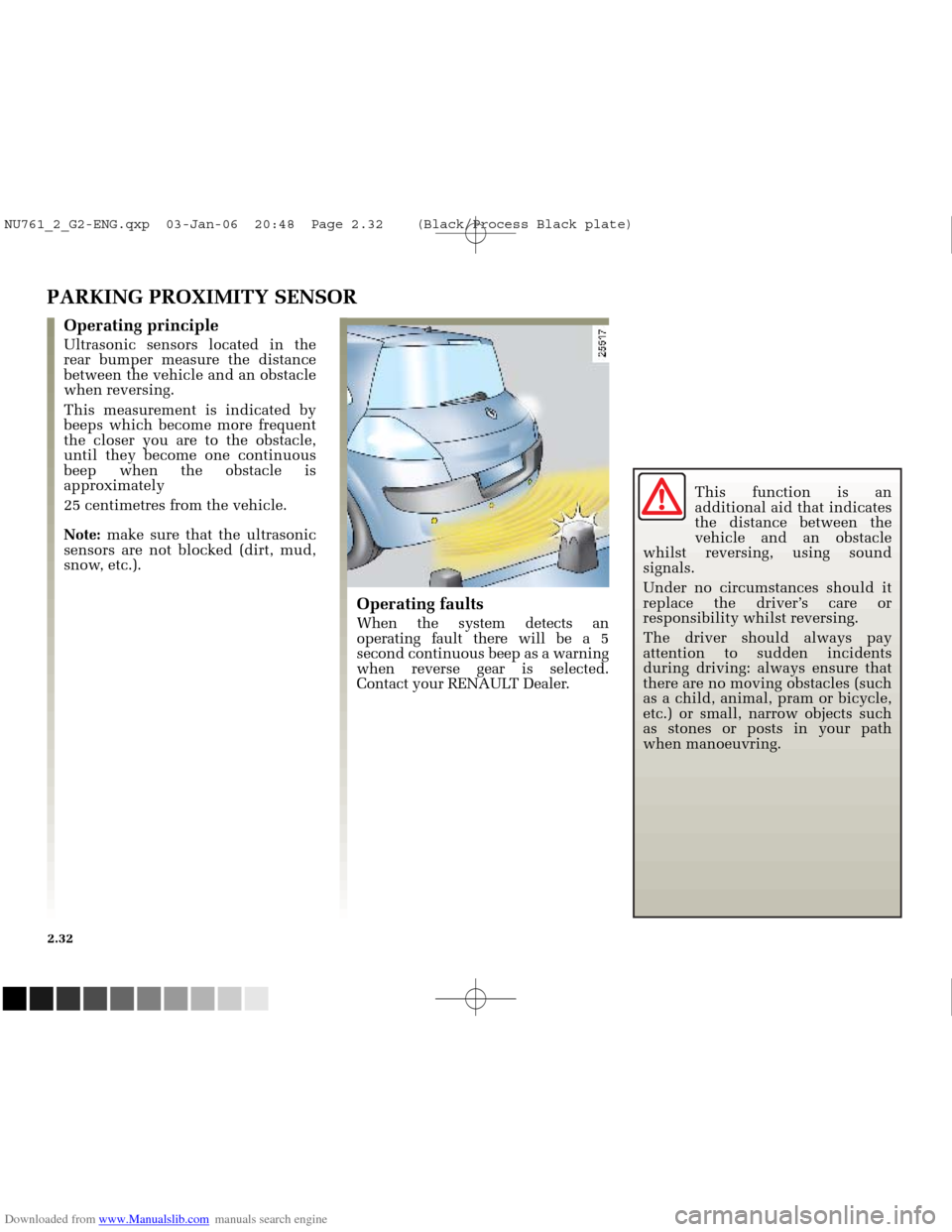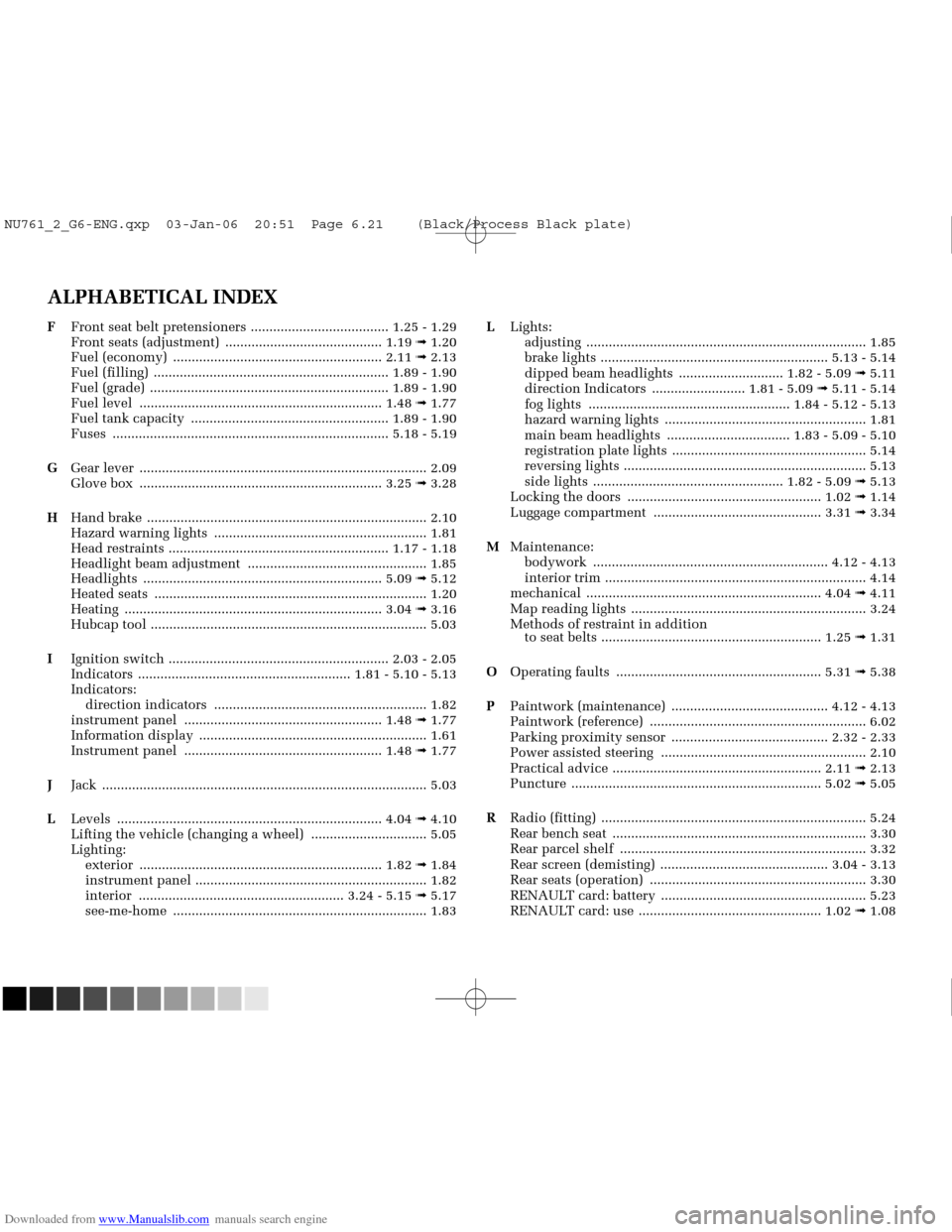2005 RENAULT MEGANE sensor
[x] Cancel search: sensorPage 119 of 250

Downloaded from www.Manualslib.com manuals search engine
A
NU761_2_G2-FRA.qxd 4/11/05 10:48 Page 2.19
ELECTRONIC STABILITY PROGRAM: ESP WITH UNDERSTEER CONTROL
When the function begins to
operate, warning light Aflashes to
warn you.
If the warning light comes on
accompanied by the “ASR/ESP
deactivated” message when the
engine is started, slowly turn the
steering wheel from lock to lock to
reinitialise the system.
Understeer control
This system optimises the operation
of the ESP in the case of pronounced
understeering (loss of front axle
roadholding).
Operating faults
If the system detects an operating
fault, the message “Check traction
control” or “ESP/ASR not
functioning” is displayed on the
instrument panel display along with
indicator light and indicator
light A.
Contact your RENAULT Dealer.
This system helps to keep control of
the vehicle in critical driving
situations (avoiding an obstacle, loss
of grip when cornering, etc.) and
works in conjunction with the
understeer control system.
Operating principle
A sensor in the steering wheel
detects the direction selected by the
driver.
Other sensors throughout the vehicle
measure the actual direction.
The system compares the direction
selected by the driver and the actual
direction of the vehicle and corrects
this as necessary by applying the
brakes selectively and/or acting on
the engine power.
2.19
This function is an
additional aid in case of
critical driving conditions
to enable the vehicle
behaviour to be adapted to suit
the driving conditions.
However, the function does not
take the place of the driver. It
does not increase the vehicle’s
limits and should not encourage
you to drive more quickly.
Therefore, it can under no
circumstances replace the
vigilance or responsibility of the
driver when manoeuvring the
vehicle (the driver must always
be ready for sudden incidents
which may occur when driving).
NU761_2_G2-ENG.qxp 03-Jan-06 20:48 Page 2.19 (Black/Process Black\
plate)
Page 120 of 250

Downloaded from www.Manualslib.com manuals search engine
A
NU761_2_G2-FRA.qxd 4/11/05 10:48 Page 2.20
2.20
TRACTION CONTROL: ASR
Operating principle
Using the wheel sensors, the system
measures and compares the speed of
the drive wheels at all times and
slows down their over-rotation.
If a wheel is starting to spin, the
system brakes automatically until
the drive supplied becomes
compatible with the level of grip.The system also adjusts the engine
speed to the grip available under the
wheels, independently of the
pressure exerted on the accelerator
pedal.
When the function begins to
operate, warning light
Aflashes to
warn you.
This system helps to limit skidding
on drive wheels and to control the
vehicle when pulling away or
accelerating.
This function is an
additional aid in case of
critical driving conditions
to enable the vehicle
behaviour to be adapted to suit
the driving conditions.
However, the function does not
take the place of the driver. I t
does not increase the vehicle’s
limits and should not encourage
you to drive more quickly.
Therefore, it can under no
circumstances replace the
vigilance or responsibility of the
driver when manoeuvring the
vehicle (the driver must always
be ready for sudden incidents
which may occur when driving).
NU761_2_G2-ENG.qxp 03-Jan-06 20:48 Page 2.20 (Black/Process Black\
plate)
Page 132 of 250

Downloaded from www.Manualslib.com manuals search engine
NU761_2_G2-FRA.qxd 4/11/05 10:48 Page 2.32
2.32
PARKING PROXIMITY SENSOR
Operating faults
When the system detects an
operating fault there will be a 5
second continuous beep as a warning
when reverse gear is selected.
Contact your RENAULT Dealer.
Operating principle
Ultrasonic sensors located in the
rear bumper measure the distance
between the vehicle and an obstacle
when reversing.
This measurement is indicated by
beeps which become more frequent
the closer you are to the obstacle,
until they become one continuous
beep when the obstacle is
approximately
25 centimetres from the vehicle.
Note:make sure that the ultrasonic
sensors are not blocked (dirt, mud,
snow, etc.). This function is an
additional aid that indicates
the distance between the
vehicle and an obstacle
whilst reversing, using sound
signals.
Under no circumstances should it
replace the driver’s care or
responsibility whilst reversing.
The driver should always pay
attention to sudden incidents
during driving: always ensure that
there are no moving obstacles (such
as a child, animal, pram or bicycle,
etc.) or small, narrow objects such
as stones or posts in your path
when manoeuvring.
NU761_2_G2-ENG.qxp 03-Jan-06 20:48 Page 2.32 (Black/Process Black\
plate)
Page 133 of 250

Downloaded from www.Manualslib.com manuals search engine
1
NU761_2_G2-FRA.qxd 4/11/05 10:48 Page 2.33
PARKING PROXIMITY SENSOR (continued)
Temporary deactivation of the
system
Press switch 1to deactivate the
system.
The warning light built into the
switch lights up to remind you that
the system has been deactivated.
Pressing the switch again will
reactivate the system and switch off
the warning light.
The system is automatically
reactivated after the ignition is
switched off and the engine
restarted.
Prolonged deactivation of the
system
You can deactivate the system
permanently by pressing the switch
for longer than approximately three
seconds.
The warning light built into the
switch remains lit permanently.
Once deactivated, the system can be
reactivated by pressing the button
again for longer than approximately
three seconds.
2.33
NU761_2_G2-ENG.qxp 03-Jan-06 20:48 Page 2.33 (Black/Process Black\
plate)
Page 195 of 250

Downloaded from www.Manualslib.com manuals search engine
NU761_2_G5-FRA.qxd 4/11/05 11:09 Page 5.07
5.07
TYRES (continued)
Pressures should be checked when
the tyres are cold; ignore higher
pressures which may be reached in
hot weather or following a fast
journey.
If the tyre pressures cannot be
checked when the tyres are cold,
assume an increase of 0.2 to 0.3 bar
(or 3 psi. ).
Never deflate a hot tyre.
Note: a label (depending on country
or model) fixed to the edge or frame
of the driver’s door gives the
recommended tyre pressures.
Changing wheels around
This practice is not recommended.
Tyre pressures
Tyre pressures must be adhered to,
tyre pressures for all wheels
(including the spare wheel) must be
checked at least once a month and
always before a long journey (refer
to the information on Tyre
pressures).
Emergency spare wheel
Refer to the information relating to
the emergency spare wheel and
changing a wheel in Section 5.
Fitting new tyres
Incorrect tyre pressures
lead to abnormal tyre
wear and unusually hot
running, factors which
may seriously affect safety and
lead to:
- poor roadholding,
- the risk of blow-outs or of throwing a tread at high speed.
The pressure depends on the load
and the speed of use. Adjust the
pressures according to the
conditions of use (refer to the
information on Tyre pressures). Vehicles equipped with
the tyre pressure monitor
Each of the sensors fitted
in the valves is dedicated
to one particular wheel: the
wheels must therefore not be
swapped around.
There is a risk of incorrect
information which could have
serious consequences. For safety reasons, this
operation must be carried
out by a specialist.
Fitting different tyres may
change your vehicle as follows:
- It may mean that your vehicle no longer conforms to current
regulations.
- It may change the way it handles when cornering.
- It may cause the steering to be heavy.
- It may cause tyre noise.
- It may affect the use of snow chains.
NU761_2_G5-ENG.qxp 1/5/2006 5:30 PM Page 5.07 (Black plate)
Page 247 of 250

Downloaded from www.Manualslib.com manuals search engine
NU761_2_G6-FRA.qxd 4/11/05 11:11 Page 6.21
ALPHABETICAL INDEX
FFront seat belt pretensioners ..................................... 1.25 - 1.29
Front seats (adjustment) .......................................... 1.19 ➟ 1.20
Fuel (economy) ........................................................ 2.11 ➟ 2.13
Fuel (filling) ............................................................... 1.89 - 1.90
Fuel (grade) ................................................................ 1.89 - 1.90
Fuel level ................................................................. 1.48 ➟ 1.77
Fuel tank capacity ..................................................... 1.89 - 1.90
Fuses ........................................................................\
.. 5.18 - 5.19
G Gear lever ........................................................................\
..... 2.09
Glove box ................................................................. 3.25 ➟ 3.28
H Hand brake ........................................................................\
... 2.10
Hazard warning lights ......................................................... 1.81
Head restraints ........................................................... 1.17 - 1.18
Headlight beam adjustment ................................................ 1.85
Headlights .............................................................\
... 5.09 ➟ 5.12
Heated seats ........................................................................\
. 1.20
Heating ................................................................\
..... 3.04 ➟ 3.16
Hubcap tool ........................................................................\
.. 5.03
I Ignition switch ........................................................... 2.03 - 2.05
Indicators ......................................................... 1.81 - 5.10 - 5.13
Indicators:
direction indicators ......................................................... 1.82
instrument panel ..................................................... 1.48 ➟ 1.77
Information display ............................................................. 1.61
Instrument panel ..................................................... 1.48 ➟ 1.77
J Jack ...................................................................\
.................... 5.03
L Levels .................................................................\
...... 4.04 ➟ 4.10
Lifting the vehicle (changing a wheel) ............................... 5.05
Lighting: exterior ...............................................................\
.. 1.82 ➟ 1.84
instrument panel .............................................................. 1.82
interior ....................................................... 3.24 - 5.15 ➟ 5.17
see-me-home ............................................................\
........ 1.83 L
Lights:
adjusting ..............................................................\
............. 1.85
brake lights ............................................................. 5.13 - 5.14
dipped beam headlights ............................ 1.82 - 5.09 ➟ 5.11
direction Indicators ......................... 1.81 - 5.09 ➟ 5.11 - 5.14
fog lights ...................................................... 1.84 - 5.12 - 5.13
hazard warning lights ...................................................... 1.81
main beam headlights ................................. 1.83 - 5.09 - 5.10
registration plate lights .................................................... 5.14
reversing lights ................................................................. 5.13
side lights ................................................... 1.82 - 5.09 ➟ 5.13
Locking the doors .................................................... 1.02 ➟ 1.14
Luggage compartment ............................................. 3.31 ➟ 3.34
M Maintenance:
bodywork ............................................................... 4.12 - 4.13
interior trim ...................................................................... 4.14
mechanical .............................................................\
.. 4.04 ➟ 4.11
Map reading lights ............................................................... 3.24
Methods of restraint in addition to seat belts ........................................................... 1.25 ➟ 1.31
O Operating faults ....................................................... 5.31 ➟ 5.38
P Paintwork (maintenance) .......................................... 4.12 - 4.13
Paintwork (reference) .......................................................... 6.02
Parking proximity sensor .......................................... 2.32 - 2.33
Power assisted steering ....................................................... 2.10
Practical advice ........................................................ 2.11 ➟ 2.13
Puncture ...............................................................\
.... 5.02 ➟ 5.05
R Radio (fitting) ....................................................................... 5.24
Rear bench seat .................................................................... 3.30
Rear parcel shelf .................................................................. 3.32
Rear screen (demisting) ............................................. 3.04 - 3.13
Rear seats (operation) .......................................................... 3.30
RENAULT card: battery ....................................................... 5.23
RENAULT card: use ................................................. 1.02 ➟ 1.08
NU761_2_G6-ENG.qxp 03-Jan-06 20:51 Page 6.21 (Black/Process Black\
plate)